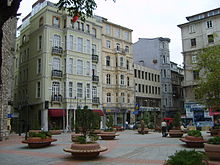
Kuledibi ("foot of the tower" in Turkish) is a quarter of İstanbul's Beyoğlu district. The term is generally used to describe the surrounding areas around the Galata Tower. The region extends to the streets parallel to Voyvoda Street in the south, Okçu Musa Street in the west (forming the upper part of Bankalar Caddesi), Yüksek Kaldırım Street in the east, Tımarcı Street and Şahkulu Street in the north.[1]
Palazzo del Comune (Ceneviz Sarayı), which was built in 1316 and served as the administrative center of the Genoese colony in İstanbul is one of the main buildings in Kuledibi quarter. Sankt Georg Church, Hospital and School (Avusturya Lisesi), Church of SS Peter and Paul, Şehsuvar Bey Masjid and Beyoğlu Göz Eğitim ve Araştırma Hastanesi are other major structures around Galata Tower.[1] Architecture of Kuledibi, especially buildings that was constructed before 20th century, exhibits varying degrees of influence from Italian Levantines that were living in İstanbul at the time.
Kuledibi, which was called La Kula ("The Tower") by Judeo-Spanish speakers,[2] had a dense Jewish population until the 1950s.[3] Neve Shalom Synagogue and Terziler Synagogue are the two temples that still serve the İstanbul's Jewish community.[1] The Camondo Steps, a pedestrian stairway designed with a unique mix of the Neo-Baroque and early Art Nouveau styles was also built by Ottoman-Venetian Jewish banker Abraham Salomon Camondo.[4]
See also[edit]
References[edit]
- ^ a b c Kuledibi, Dünden Bugüne İstanbul Ansiklopedisi, c. 5, s. 114-115, İstanbul, 1994.
- ^ Kohen, Elli (2007). History of the Byzantine Jews: A Microcosmos in the Thousand Year Empire. University Press of America. ISBN 9780761836230.
- ^ Kaptan, Özdemir (1989). Beyoğlu: (kısa geçmişi, argosu) (in Turkish). İletişim yayınları. ISBN 9789754700015.
- ^ "Camondo Steps on the Bankalar Caddesi". Archived from the original on 2011-09-03. Retrieved 2019-11-05.
Well, that’s interesting to know that Psilotum nudum are known as whisk ferns. Psilotum nudum is the commoner species of the two. While the P. flaccidum is a rare species and is found in the tropical islands. Both the species are usually epiphytic in habit and grow upon tree ferns. These species may also be terrestrial and grow in humus or in the crevices of the rocks.
View the detailed Guide of Psilotum nudum: Detailed Study Of Psilotum Nudum (Whisk Fern), Classification, Anatomy, Reproduction